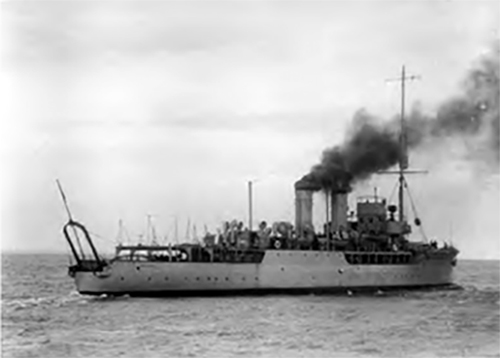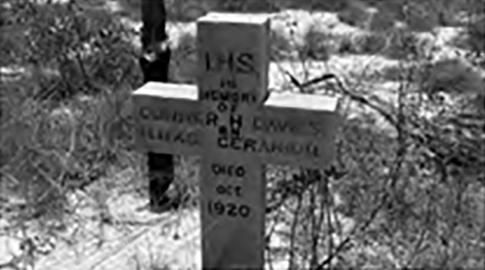- Author
- Swinden, Greg
- Subjects
- Biographies and personal histories, History - Between the wars
- Tags
-
- RAN Ships
- HMAS Geranium, HMAS Brisbane I
- Publication
- March 2015 edition of the Naval Historical Review (all rights reserved)
This article was first published by the Military History & Heritage Society of Victoria and is reproduced with their kind permission and that of the author.
In the far north of Western Australia lies perhaps Australia’s most isolated war grave. In the now overgrown and forgotten Drysdale River Mission Station cemetery at Pago, Western Australia lie the remains of Warrant Officer (Gunner) John Henry Davies who had the misfortune to be killed by a crocodile while serving in the survey vessel HMAS Geranium in 1920.
John Henry Davies was born in the London suburb of Camberwell on 10 December 1882. He was a long serving member of both the RN and RAN having first enlisted in the RN in the early 1900s. He joined the RAN on 30 December 1913 with the rank of Petty Officer (having already completed eight years service in the RN) and after serving in HMAS Cerberus joined the cruiser HMAS Sydney in early October 1914. He was present at the action between Sydney and the German cruiser Emden at Cocos Island on 9 November 1914, where he served as a member of Sydney’s guns crew, who suffered four dead and 12 wounded. Davies continued to serve in Sydney until October 1915 during which time the cruiser operated on the North American and West Indies Station, patrolling to ensure German merchant ships remained in neutral harbours and searching for the German cruiser Karlsruhe which was active in South American waters.
Petty Officer Davies was then selected for further gunnery training at the RN Gunnery School (HMS Excellent at Whale Island) and by March 1916 he had also been promoted to the rank of Gunner (the equivalent of Warrant Officer). In January 1917 he joined the newly commissioned cruiser HMAS Brisbane and served in her for the next three years. During 1917 Brisbane conducted patrols of the Indian and Pacific Oceans searching for the elusive German raider Wolf which had been active in both areas laying mines and sinking or capturing merchant ships; but the raider was never found. In 1918 Brisbane carried out patrols on the Australian Station to prevent attacks on merchant shipping by German raiders and in October 1918 was dispatched to the Mediterranean theatre. The war ended before the cruiser arrived in the Mediterranean, but, she remained on station and was attached briefly to the Allied naval forces operating in the Black Sea (supporting the White Russian forces against the Bolsheviks in what was effectively a Russian Civil War). Brisbane then undertook a refit in England before returning to Australia in June 1919.

During late 1919 and early 1920, Gunner Davies was briefly attached to the depot ships HMAS Penguin (based in Sydney) and Cerberus (based at Williamstown) before joining the newly commissioned survey vessel HMAS Geranium in late July 1920. Geranium was an ex-RN Flower class sloop which had been employed on minesweeping duties in Australian and New Zealand waters during late 1919 and was then converted to a survey vessel. Geranium sailed from Sydney in August 1920 bound for Darwin and after arriving there commenced her survey work in northern waters.
On 26 September 1920 Geranium landed a survey party in Napier Broome Bay on the far north coast of Western Australia. Survey parties were required to take readings of tidal heights over a period of time and conduct other surveying duties. Gunner Davies was part of this group and some time after the men landed he ‘went missing’. An initial search was conducted but failed to find any sign of the missing officer. On the 28th Aboriginal trackers from the Mission Station at Drysdale River were brought in by police but after five days the search was abandoned and the missing Gunner was believed to have been taken by a crocodile. His service record was notated as Missing believed dead 26/09/20.
The Mission Station at Drysdale River (Pago) had been established in 1908 by New Norcia Benedictine monks and was located near the bottom of Napier Broome Bay. In 1936-37 this site was abandoned and the main mission was moved some 20 km south west to a site at Kalumbura Pool on the King Edward River where it still exists.
On or about 16 October 1920 the remains of Gunner Davies were found by a Western Australian policeman and a Father Fulgentius, from the Mission Station, lying in mangroves some distance inland from Napier Broome Bay. The entry in the Mission Station diary reads:
Today we had the burial, in the new cemetery, of the remains of the official who was taken by a sharp tooth of a crocodile. They consisted of a leg, the trunk without a head or arms, only the chest had flesh on it. Fr Fulgentius and a policeman found them and brought them in a bag. At 4.30 pm they were put in a box and then a small procession was made to the cemetery. Fr Fulgentius conducted a simple service, because it was not known which religion he was. A cross was placed at the head.

Author’s image
On 8 November 1920 a Court of Inquiry into the death of Warrant Officer Davies was held onboard the cruiser Brisbane alongside in Sydney. Although no copy of the proceedings of the inquiry has been found to date, the outcome was listed on his service record as:
This officer was killed by an alligator (sic) while crossing a creek. His remains were buried at Drysdale River Mission by the Rev’d Father. Date of Death fixed as 1/10/20.
Sometime after his death the men from Geranium returned to the Mission Station and had a stone slab and concrete cross erected over the grave of Gunner Davies; and despite the passage of time and ravages of weather it still stands there today.
By Editor
During WWII a temporary airfield was constructed next to the Drysdale Mission, supported by a small Army base and radar station. The strip was used as a refuelling and ammunition depot for RAAF anti-submarine aircraft operating between Darwin and Fremantle. In December 1942 it was used as staging post for Beaufighters of 31 Squadron which attacked and destroyed enemy aircraft on the ground at Koepang on Timor. The Japanese took their revenge on 27 September 1943 when the airstrip and mission were bombed by 21 Kawasaki ‘Lily’ bombers from Timor escorted by Navy ‘Zeros’. The ammunition dump exploded and a direct hit on a slit trench at the mission killed Father Thomas Gil and five of his aboriginal charges. They are all buried at the mission graveyard. In 1944 the base was relocated to nearby Truscott Airfield which also closed after the war and is now used as a commercial facility.




